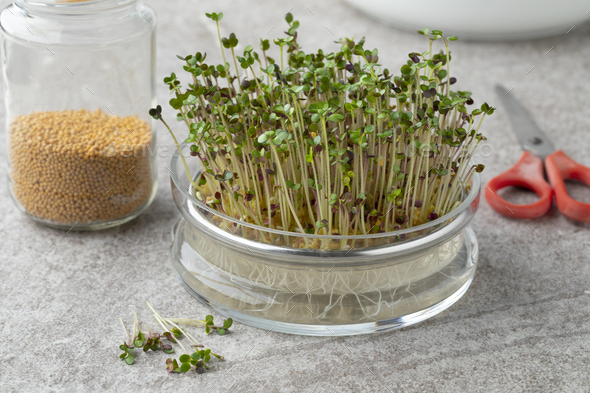Sprouts are seeds that have germinated and started growing, but have not matured into mature plants. Seeds of alfalfa, clover, beans, radishes and mustard are commonly germinated, but many other types of seeds are used for germination. Mustard sprouts grow from mustard seeds, and the flavor of the sprouts depends on the type of seeds being germinated. There are several different types of mustard seeds commonly used for germination; which one to use is usually a matter of personal taste.
When growing mustard seedlings, the seeds must be soaked, then rinsed and drained many times, usually about three times a day. Some mustard seeds are quite small and difficult to handle, but if dried through a few layers of cheesecloth, they will not be lost. After the seeds germinate and release tiny roots, they should be kept in a bright, sunny place to turn green. Sprouts that do not receive sunlight are pale, and the leaves are usually yellowish rather than green, but they can be eaten and some people even prefer them.
Each sprout type has its own unique flavor and the seeds are usually mixed together to create an individual sprout mix. Mustard sprouts generally have a savory flavor. Eastern mustard seeds grow as sharp as horseradish. Brown mustard sprouts are very spicy, but not as pungent as the oriental varieties. Yellow mustard sprouts are very aromatic, but not as pungent as the other two.
Mustard sprouts mix well with other varieties such as radishes and onions or clover and alfalfa to create a crispy salad mix with added spices. The mixed seeds are germinated in the same way as mustard sprouts, with a second rinse followed by an intermediate period for growth. The most important thing when creating a mixture is to make sure that all the seeds germinate at the same time as the mustard seeds.
The sprouts can be eaten in a variety of ways. Raw sprouts are not only eaten neat, but also added to sandwiches and salads for flavor. They can also be used to add a uniquely spicy flavor to prepared meals such as soups and casseroles. Mixing mustard sprouts with whole grain and special flours creates a uniquely flavored bread.

Instructions for use:
Pour the amount reguired in to a bowl of water at room temperature and allow them to soak for 8-10 hours.
Subsequently place the seeds into your sprouter covering no more than 25% of the tray as the seeds will in size. Put the sprouter in a light spot at room temperature changing the water 2-3 times a day.
The sprouts will be ready in about 6-10 days. Cut the sprouts about the seed and wash them before eating. They will keep in the fridge for up to a week (8-10 days).











